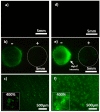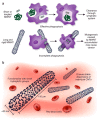Overview of Carbon Nanotubes for Biomedical Applications
- PMID: 30791507
- PMCID: PMC6416648
- DOI: 10.3390/ma12040624
Overview of Carbon Nanotubes for Biomedical Applications
Abstract
The unique combination of mechanical, optical and electrical properties offered by carbon nanotubes has fostered research for their use in many kinds of applications, including the biomedical field. However, due to persisting outstanding questions regarding their potential toxicity when considered as free particles, the research is now focusing on their immobilization on substrates for interface tuning or as biosensors, as load in nanocomposite materials where they improve both mechanical and electrical properties or even for direct use as scaffolds for tissue engineering. After a brief introduction to carbon nanotubes in general and their proposed applications in the biomedical field, this review will focus on nanocomposite materials with hydrogel-based matrices and especially their potential future use for diagnostics, tissue engineering or targeted drug delivery. The toxicity issue will also be briefly described in order to justify the safe(r)-by-design approach offered by carbon nanotubes-based hydrogels.
Keywords: diagnostic; drug delivery; hydrogels; nanocomposites; tissue engineering.
Conflict of interest statement
The authors declare no conflict of interest.
Figures






References
-
- Monthioux M., Serp P., Caussat B., Flahaut E., Razafinimanana M., Valensi F., Laurent C., Peigney A., Mesguich D., Weibel A., et al. Carbon Nanotubes. In: Bhushan B., editor. Springer Handbook of Nanotechnology. Springer Handbooks; Berlin, Germany: 2017. pp. 193–247.
Publication types
Grants and funding
LinkOut - more resources
Full Text Sources

